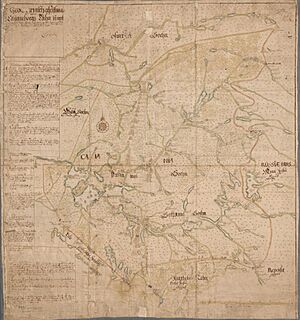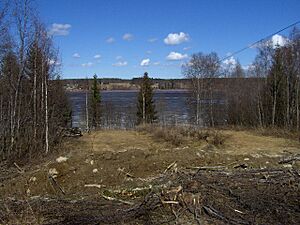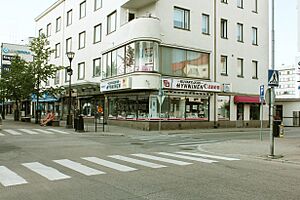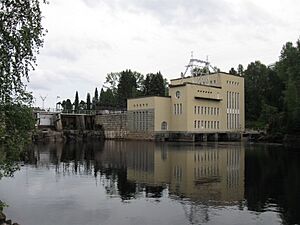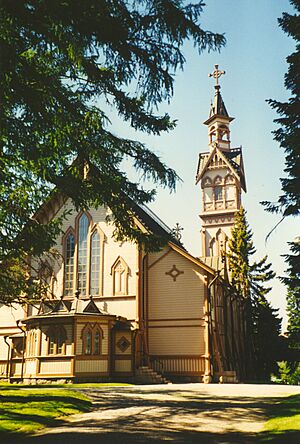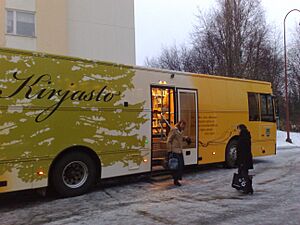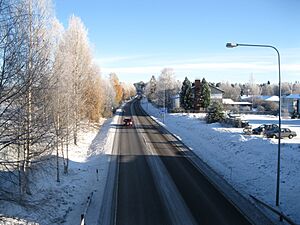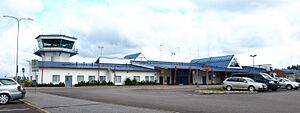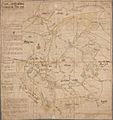Kajaani facts for kids
Quick facts for kids
Kajaani
Kajana
|
||
|---|---|---|
|
Town
|
||
| Kajaanin kaupunki Kajana stad |
||
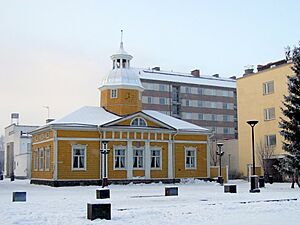
The old Town hall
|
||
|
||

Location of Kajaani in Finland
|
||
| Country | ||
| Region | Kainuu | |
| Sub-region | Kajaani sub-region | |
| Charter | 6 March 1651 | |
| Area
(2018-01-01)
|
||
| • Total | 2,263.99 km2 (874.13 sq mi) | |
| • Land | 1,834.83 km2 (708.43 sq mi) | |
| • Water | 428.94 km2 (165.61 sq mi) | |
| Area rank | 33rd largest in Finland | |
| Population
(2023-12-31)
|
||
| • Total | 36,513 | |
| • Rank | 31st largest in Finland | |
| • Density | 19.9/km2 (52/sq mi) | |
| Population by native language | ||
| • Finnish | 93% (official) | |
| • Swedish | 0.1% | |
| • Others | 6.8% | |
| Population by age | ||
| • 0 to 14 | 15.6% | |
| • 15 to 64 | 60.4% | |
| • 65 or older | 24% | |
| Time zone | UTC+02:00 (EET) | |
| • Summer (DST) | UTC+03:00 (EEST) | |
| Website | Official website: http://www.kajaani.fi/ | |
Kajaani is a town in Finland and the main city of the Kainuu region. It is located southeast of Lake Oulu. About 37,000 people live in Kajaani. It is one of the largest municipalities in Finland by population.
The town was founded in the 17th century. It grew because of the tar industry, which made tar from pine trees. During the Great Northern War, Russian forces destroyed Kajaani Castle in 1716. Today, Kajaani's economy mainly relies on the sawmill, lumber, and paper businesses. Kajaani Church was built in 1896 in a special style called Neo-Gothic. Kajaani also has a town theatre, two football clubs, and an ice hockey team. It is home to LUMI, which is the fastest supercomputer in the EU.
Contents
History of Kajaani
Kajaani was one of the cities founded on March 6, 1651. It was started by Per Brahe the Younger, who was the Swedish Governor General of Finland. At that time, the Kainuu region was very important for making tar from wood. Selling tar was the main business.
During a time called the Greater Wrath in the 18th century, Kajaani Castle had to give up to Russian forces. The Russians blew up the castle in March 1716. It has been in ruins ever since. In 1808, General Johan August Sandels won an important battle near Kajaani during the Finnish War.
In 1833, a doctor named Elias Lönnrot came to Kajaani. He is famous for putting together the Kalevala, which is Finland's national story. He helped with a sickness that was spreading in the 1830s. Kajaani was also badly affected by a famine in 1867-1868. But the town slowly got better. By the end of the 1800s, it had more than 1200 people. The Kajaani Town Hall was built in 1831, and the Kajaani Church was built in 1896.
The paper industry became very important in Kajaani in the early 1900s. The Kajaani Paper Mill was built in 1907. It was a big employer for many years. The city grew a lot in the 1960s and 1970s. In 1977, the rural area around Kajaani joined with the city, making the population jump to over 34,000 people.
Geography and Nature
Kajaani is located in the middle of Finland. It is about 558 kilometers (347 miles) north of Helsinki. Kajaani is on the Kajaani River, between Lake Oulu and Nuasjärvi. Smaller lakes like Sokajärvi and Paltajärvi are also nearby. These lakes freeze during winter. The Kajaani and Vuolijoki rivers are popular for fishing.
The area around Kajaani has many conifer forests. You can also find birch and alder trees near the rivers. The Talaskangas Nature Reserve is a special place with old natural forests. It is home to about 50 different kinds of wildlife. This reserve was created in 1994 to protect the nature.
Climate in Kajaani
Kajaani has a subarctic climate. This means it has long, cold winters and short, cool summers. However, because it is close to the Baltic Sea, the weather is milder than in many other places at the same latitude.
Summers are cool, with July usually being the warmest month. The average high temperature in July is about 20 °C (68 °F). But sometimes, it can get as hot as 31 °C (88 °F) or even 34.5 °C (94.1 °F). Summers also have the most rain. Winters can be very cold, with temperatures sometimes dropping below -30 °C (-22 °F). The coldest time is usually from December to March. January usually has the most snowfall.
| Climate data for Kajaani | |||||||||||||
|---|---|---|---|---|---|---|---|---|---|---|---|---|---|
| Month | Jan | Feb | Mar | Apr | May | Jun | Jul | Aug | Sep | Oct | Nov | Dec | Year |
| Record high °C (°F) | 8.7 (47.7) |
7.0 (44.6) |
13.0 (55.4) |
20.5 (68.9) |
28.0 (82.4) |
31.3 (88.3) |
34.5 (94.1) |
30.7 (87.3) |
25.1 (77.2) |
19.8 (67.6) |
10.5 (50.9) |
7.3 (45.1) |
34.5 (94.1) |
| Mean daily maximum °C (°F) | −6.3 (20.7) |
−6.0 (21.2) |
−0.9 (30.4) |
5.5 (41.9) |
12.7 (54.9) |
17.9 (64.2) |
20.9 (69.6) |
18.3 (64.9) |
12.5 (54.5) |
5.0 (41.0) |
−0.4 (31.3) |
−3.8 (25.2) |
6.3 (43.3) |
| Daily mean °C (°F) | −9.5 (14.9) |
−9.7 (14.5) |
−5.0 (23.0) |
1.2 (34.2) |
7.8 (46.0) |
13.4 (56.1) |
16.2 (61.2) |
14.0 (57.2) |
8.9 (48.0) |
2.8 (37.0) |
−2.4 (27.7) |
−6.4 (20.5) |
2.6 (36.7) |
| Mean daily minimum °C (°F) | −13.7 (7.3) |
−14.3 (6.3) |
−10.0 (14.0) |
−3.6 (25.5) |
2.1 (35.8) |
7.9 (46.2) |
11.1 (52.0) |
9.4 (48.9) |
5.1 (41.2) |
0.1 (32.2) |
−5.3 (22.5) |
−10.2 (13.6) |
−1.8 (28.8) |
| Record low °C (°F) | −42.0 (−43.6) |
−42.8 (−45.0) |
−35.5 (−31.9) |
−24.7 (−12.5) |
−10.7 (12.7) |
−4.3 (24.3) |
−0.1 (31.8) |
−3.5 (25.7) |
−10.5 (13.1) |
−22.9 (−9.2) |
−34.3 (−29.7) |
−40.4 (−40.7) |
−42.8 (−45.0) |
| Average precipitation mm (inches) | 37 (1.5) |
34 (1.3) |
31 (1.2) |
30 (1.2) |
56 (2.2) |
78 (3.1) |
99 (3.9) |
84 (3.3) |
54 (2.1) |
53 (2.1) |
45 (1.8) |
43 (1.7) |
644 (25.4) |
| Source 1: FMI climatological normals for Finland 1991-2020
https://en.ilmatieteenlaitos.fi/ |
|||||||||||||
| Source 2: Record highs and lows
https://kilotavu.com/fmi-tilastot.php |
|||||||||||||
People of Kajaani
| Population of Kajaani (Dec 31) | |
|---|---|
| Year | Population |
|
|
|
|
|
|
|
|
|
|
|
|
|
|
|
|
|
|
|
|
|
As of 31 December 2023, Kajaani has a population of about 36,513. The town itself has around 34,000 people. The total area of Kajaani is 2,263.99 square kilometres (874.13 sq mi), with some of it being water.
Most people in Kajaani speak Finnish. Only a very small number of people speak Swedish as their first language.
Economy and Jobs
In the past, Kajaani was famous for its tar industry. Today, the main jobs are in the sawmill, lumber, and paper businesses. The Kajaani paper mill was a very important employer for many years. It was built in 1907. Even though it closed for a while in 2008, it later started working again.
Kajaani also has an electronics manufacturing plant. The city earns money from selling wood products and from tourism. Fishing is also a way for some people to earn money. Kajaani has several hotels and restaurants, offering different kinds of food.
The Central Hospital of Kainuu is in Kajaani. It helps people from the whole region. The Kainuu Brigade, a part of the Finnish Army, is also a big employer in the city. It trains about 4,000 young people every year.
Famous Landmarks
Kajaani Castle is on an island in the Kajaani river, right in the middle of the city. It was built in 1604. The castle was used as a place for government, a prison, a military base, and a safe place for people. The Town Hall of Kajaani was built in 1831. It has a clock tower and looks very nice after being restored in 1990.
Kajaani Church was built in 1896. It has a special Neo-Gothic style. It is made of wood and has a tall, thin bell tower. There is also a Kajaani Orthodox Church, which was finished in 1959.
The Eino Leino House is a cafe built to remember the famous poet Eino Leino, who was from Kajaani. The Urho Kekkonen Memorial is a tall monument dedicated to Urho Kekkonen, who was the eighth president of Finland.
Culture and Arts
The Kajaani Town Theatre started in 1969. It puts on plays and concerts for people to enjoy. The Art Museum of Kajaani was founded in 1993. It shows Finnish modern art. The Kainuu Museum tells stories about the tar industry, the Kalevala (Finland's national epic), and the author Elias Lönnrot.
Kajaani has important yearly cultural events. These include Kajaanin Runoviikko (The Kajaani Poetry Week) and Kainuun JazzKevät (The Kainuu Jazz Spring). The Kajaani Orchestra started in the 1950s.
Radio Kajaus is one of Finland's oldest local radio stations. It started in Kajaani in 1989. Kainuu Radio also broadcasts from Kajaani.
Learning and Education
Kajaani is home to the Kajaani University of Applied Sciences. This university offers courses in things like tourism, information systems, nursing, and business. It has both Bachelor's and Master's degree programs.
In 2022, the LUMI supercomputer started working in Kajaani. It is one of the fastest supercomputers in the world and the fastest in Europe! This is a very important place for science and technology.
The Kainuu Music Institute was founded in 1957. It is one of the biggest music schools in Finland, with about 900 students. The public library in Kajaani has free internet access. There is also a mobile library that travels around.
Sports and Fun
Kajaani has two football clubs: AC Kajaani and Kajaanin Haka. They both play their home games at the Kajaanin Liikuntapuisto stadium. The local ice hockey team is called Hokki. They play in the Mestis league.
The Kajaani ice rink was opened in 1989. It can hold over 2,300 people. There is also a race course for horses near Kajaani, which hosts competitions in the summer.
Kajaani has many ways to stay active. You can find hiking paths, skiing tracks, gyms, and sports fields. Pöllyvaara and the Vimpeli Hills are popular places for skiing in winter. Fishing is also a favorite activity along the river. Kajaani also has a golf course and places for dancing.
Getting Around Kajaani
There are two main highways that lead to Kajaani from Helsinki: Highway 5 and Highway 6. Highway 22 comes from Oulu. Buses run daily between Kajaani, Oulu, and other towns.
Kajaani railway station opened in 1905. Trains arrive daily from Helsinki, and the journey takes about 7 to 10 hours. There are also trains from Joensuu.
Kajaani Airport is about 7 kilometers (4 miles) northwest of Kajaani. It is the main local airport. It started operating fully in 1956. You can fly from Kajaani to Helsinki. In 2013, over 74,000 passengers used the airport.
Notable People from Kajaani
- Antti Halonen, ice hockey player
- Eino Leino, poet and journalist
- Elias Lönnrot, who collected the Kalevala stories
- Henrik Flöjt, biathlon athlete
- Jorma Korhonen, judoka
- Jouko Karjalainen, skier
- Marko Kemppainen, skeet shooter
- Matti Heikkinen, skier
- Mika Lavento, professor of archaeology
- Olli Malmivaara, ice hockey player
- Pekka Suorsa, ski jumper
- Riku Nieminen, actor and dancer
- Sakari Kukko, musician
- Tommi Leinonen, ice hockey player
- Urho Kekkonen, 8th President of Finland
- Kasperi Heikkinen, Guitar player
Kajaani's Sister Cities
Kajaani has "twin towns" or "sister cities" around the world. These are cities that have special friendly relationships with Kajaani.
| City | Country | Year | Ref |
|---|---|---|---|
| Östersund | 1943 | ||
| Rostov-on-Don | 1956−2022 | ||
| Schwalm-Eder-Kreis | 1973 | ||
| Nyíregyháza | 1981 | ||
| Marquette | 1997 | ||
| Jiujiang | 2006 | ||
| Bayonne | 2008 |
Images for kids
See also
 In Spanish: Kajaani para niños
In Spanish: Kajaani para niños



